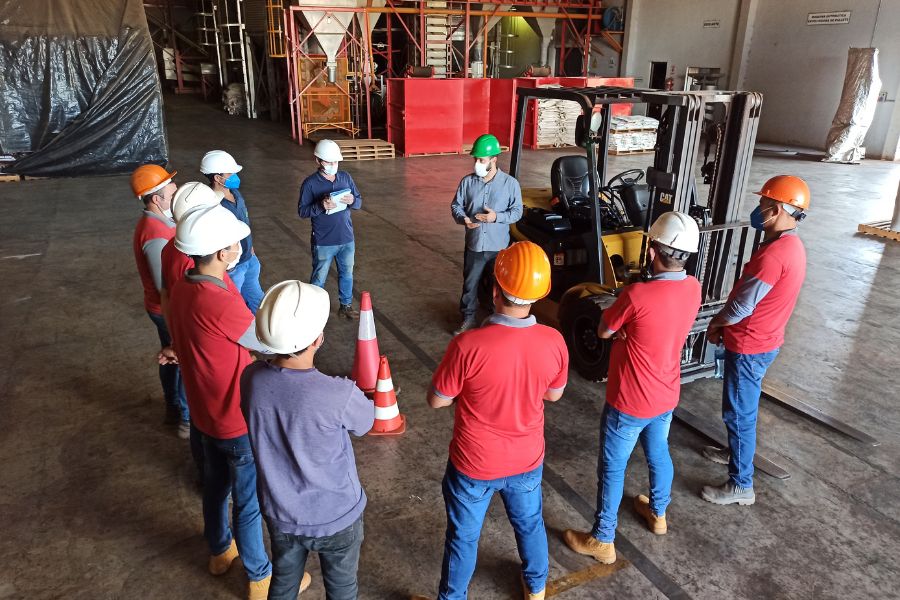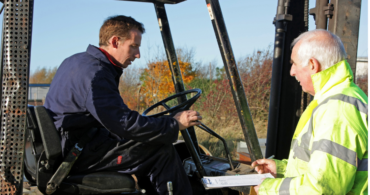Forklifts weigh several thousand pounds, can travel up to 20 miles per hour and frequently have obstructed views and uneven weight distribution. Operating these machines can be risky. Fortunately, with careful caution, most forklift accidents are avoidable.
From Oct. 1, 2021, through Sept. 30, 2022, the Occupational Safety and Health Administration (OSHA) gave out nearly 2,000 violations for forklift infractions. Forklifts (or powered industrial vehicles) rank seventh on OSHA’s list of top 10 most frequently cited standards. OSHA updates its fines each calendar year and adjusts for inflation. For 2023, OSHA’s maximum penalty for serious and other-than-serious violations is $15,625 per violation, and the maximum penalty for willful or repeated violations is $156,259 per violation.
The main forklift violations are:
- Unsafe operation, such as driving with an elevated load, going too fast and not following loading dock safety procedures.
- Employers failing to provide refresher training.
- Missing or inadequate forklift operator certification.
- Failure to remove unsafe trucks from service.
- Failing to perform a daily pre-operation inspection.
Interestingly, every one of these violations is easily avoidable. If you’ve ever seen a forklift meme, you know that some of the worst forklift accidents are caused by poor decisions or operator error. The most recent OSHA statistics list approximately:
- 85 fatal forklift accidents per year.
- 35,000 forklift accidents with serious injuries.
- 62,000 non-serious forklift accidents.
What are the main causes of injuries when using forklifts?
According to OSHA, the most common forklift accidents are:
Forklift rollovers
Not only are rollovers a significant cause of forklift accidents, but according to the CDC, they are “the leading cause of fatalities involving forklifts.” Rollovers result in “about 25% of all forklift-related deaths.”
The leading cause of rollovers is when the machine becomes imbalanced. Forklifts are counterbalanced by heavy weights in the back that offset the heavy load in the front. However, that delicate stability can be disrupted by:
- Driving with the load raised too high.
- Carrying an uneven or unbalanced load.
- Driving too fast.
- Turning too quickly.
- Turning on an incline.
- Driving on uneven surfaces.
Pedestrian accidents
Collisions with pedestrians are one of the most dangerous warehouse forklift accidents. Forklifts consistently operate in the same vicinity as roving workers. If the forklift operator or a pedestrian loses focus, the risk of a severe accident increases. After rollovers, the three leading causes of a fatal forklift accident are:
- Crushed between the forklift and a surface.
- Crushed between two vehicles.
- Struck or run over by a forklift.
Falling containers
Improperly loaded cargo, which means the load is uneven or contains more than one container, creates a dangerous situation for the operator and anyone nearby. A falling load can injure someone, and the contents could become dislodged and cause harm.
Falling to a lower level
Uneven loading platforms and tractor-trailer thresholds are dangerous locations for forklifts. The leading causes of lower-level falls are:
- Trucks or trailers rolling away.
- Slippery floors.
- Worn or damaged floors.
Driving into storage racks or knocking a pallet loose
Driving carelessly, speeding or turning too fast are the leading causes of knocking into a pallet rack. This action can damage a forklift or knock down a shelving unit, and smacking into a rack is a leading cause of falling pallets.
Inadequate operator training
OSHA estimates that proper safety training could prevent approximately 70% of all fork truck accidents. Fortunately, training and certification are mandated for every forklift operator before stepping into a vehicle. However, the issue typically isn’t that operators are not initially trained. The problem typically arises through a lack of refresher training.
What is the forklift speed limit?
OSHA allows employers to determine the speed appropriate for their specific worksites. However, while there is no single forklift speed limit OSHA has listed guidelines that employers can use to determine what is safe. “These factors include, but are not limited to, the type of truck itself, the manufacturer’s limitations on the truck, the load being carried, adequate stopping distances, operating surface conditions, pedestrian traffic and other safety issues.”
Also, don’t let the fact that a posted speed limit is nonexistent trick you into believing that a worksite can operate like the lawless Wild West. OSHA will issue a citation if they believe an operator is driving at an unsafe speed. “OSHA would consider the totality of the circumstances surrounding the operation of the powered industrial truck in determining whether safe travel speeds are practiced at a workplace.”
When is it acceptable to carry a pedestrian on a forklift?
OSHA has set two standards for when it is safe to carry a pedestrian on a forklift, and both must be met for the practice to be acceptable. According to the Powered Industrial Trucks (Forklifts) eTool on pedestrian traffic, pedestrians should “never ride on a forklift unless authorized and the forklift is designed for riders.”
What areas on a forklift can cause injuries?
Well, if someone is careful, the ideal answer is none of the areas can cause forklift accidents. Unfortunately, we don’t live in a world of make-believe with flowers, and bells, and leprechauns and magic frogs with funny little hats. So, when operators and pedestrians do not exercise the appropriate level of caution, pretty much any area on a forklift can cause an accident.
- Forks: improperly secured loads can dislodge, injuring operators or bystanders.
- Tires: moving wheels can flatten feet and toes.
- Operator’s compartment: not wearing a seat belt or standing while in motion may cause the driver to fall or be tossed from the forklift.
- Mast: the uprights can obstruct visibility and cause a collision with an object or pedestrian.
- Pedals: feet can get caught and smooshed, especially if wearing inappropriate footwear.
- Battery compartment: leaking or improperly maintained batteries can be hazardous to operators and other employees.
- Hydraulic systems: hands or clothing could become caught in lifting and tilting mechanisms.
- Exhaust: poorly ventilated areas or enclosed spaces can lead to exhaust exposure.
- Steps: if a surface becomes slippery, climbing on it may cause a fall.
- Attachments: improper use of clamps, side shifters or booms can result in load instability and accidents.
How can you decrease the likelihood of injuries while using forklifts?
OSHA has many valuable suggestions to help operators and worksite managers avoid forklift accidents.
Forklift operations
- Always operate the vehicle according to the manufacturer’s instructions.
- Always wear a seat belt.
- Never exceed the rated load and ensure it is stable and balanced.
- Do not raise or lower the load while traveling.
- Keep a safe distance from platform and ramp edges.
- Be aware of other vehicles in the work area.
- Have clear visibility of the work area and ensure you have enough clearance when raising, loading and operating a forklift.
- Use proper footing and the handhold, if available, when entering the lift.
- Use horns at cross aisles and obstructed areas.
- Watch for pedestrians and observe the speed limit.
- Do not give rides or use the forks to lift people.
Safety training
- Only trained and certified workers may operate a forklift.
- Ensure operators are trained on the types of trucks in use.
Forklift maintenance
- Remove from service any forklift found to be in unsafe operating condition.
- Keep forklifts in clean condition, free of excess oil and grease.
- Repair and maintain according to the manufacturer’s recommendations.
In addition, workplaces should establish a regular forklift maintenance schedule. Routine inspections can identify potential issues before they become safety hazards. Also, operators need to train in responding to emergencies, such as tip-overs, stuck loads and other hazardous situations.
Designate pedestrian zones and walkways by painting yellow traffic lines on the floor or installing permanent protective barriers. In addition, operators and pedestrians should wear appropriate personal protective equipment, such as high-visibility vests, helmets and steel-toed boots.
Creating a safe work environment and preventing forklift accidents is everybody’s responsibility. Maintaining your forklift fleet, including forklift battery maintenance, is essential to workplace safety. That’s why Texas Motive Solutions provides a complimentary forklift fleet performance analysis to ensure your fleet operates at peak efficiency. Give us a call at (888) 316-2459 or fill out this form to learn about our services and discover everything we can do for you.


